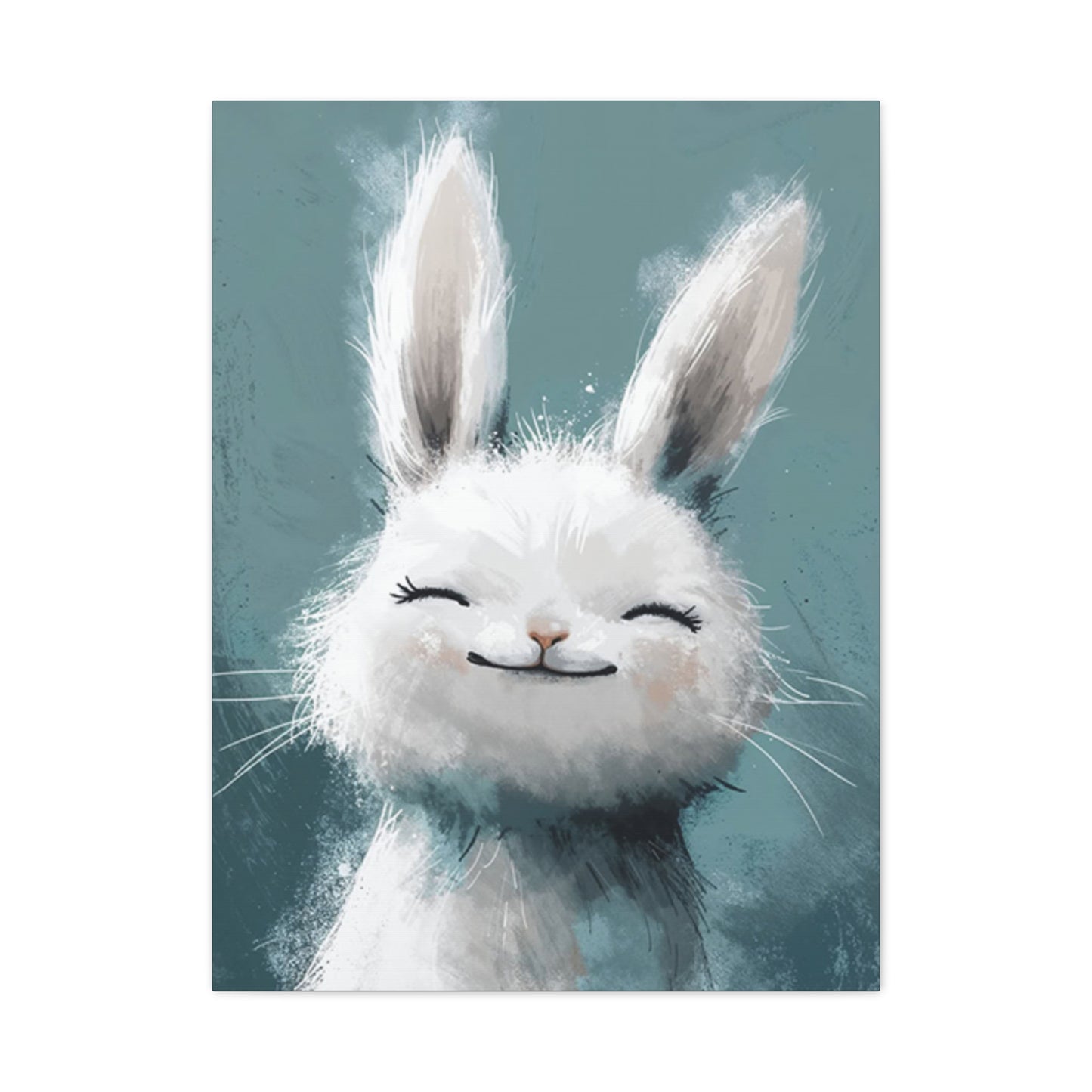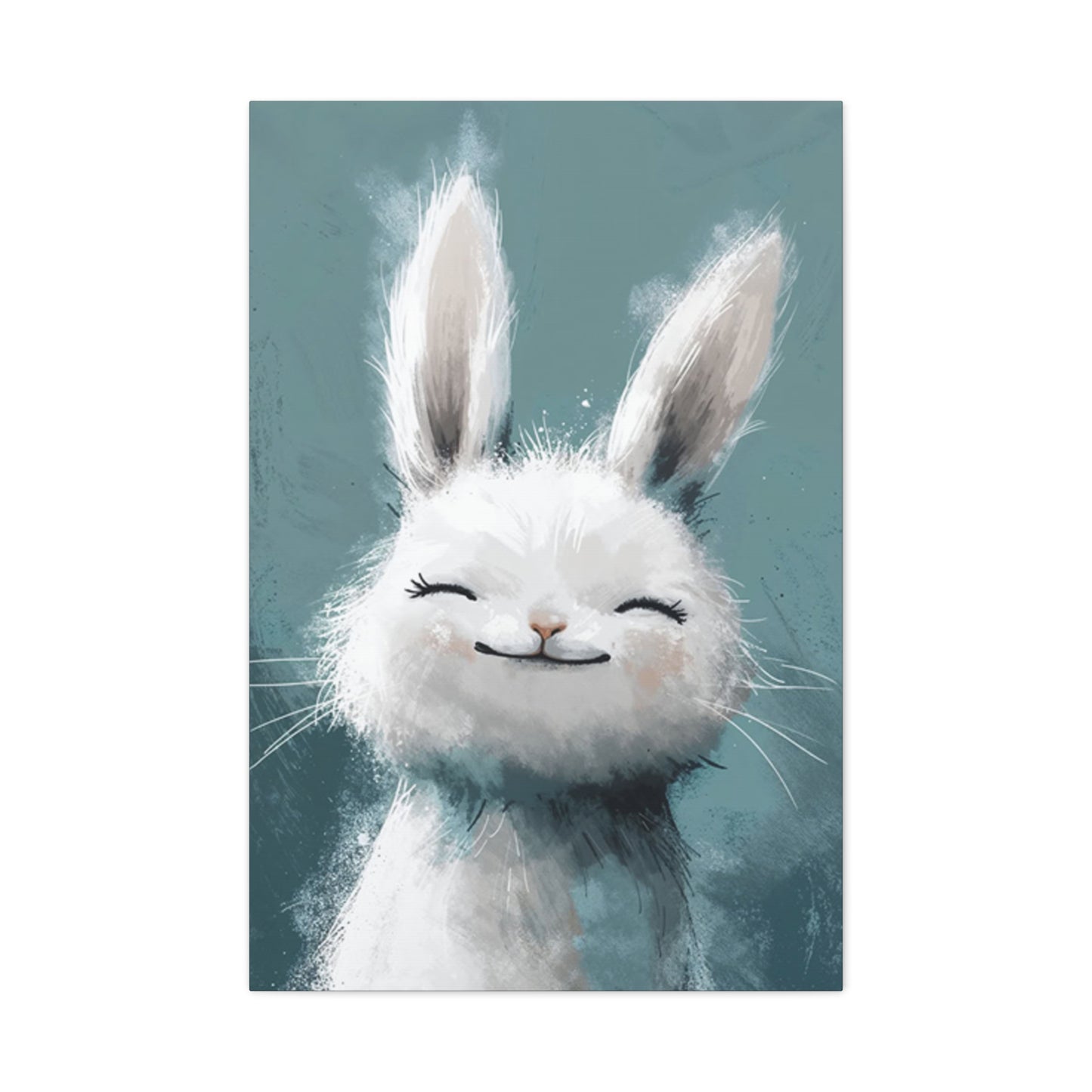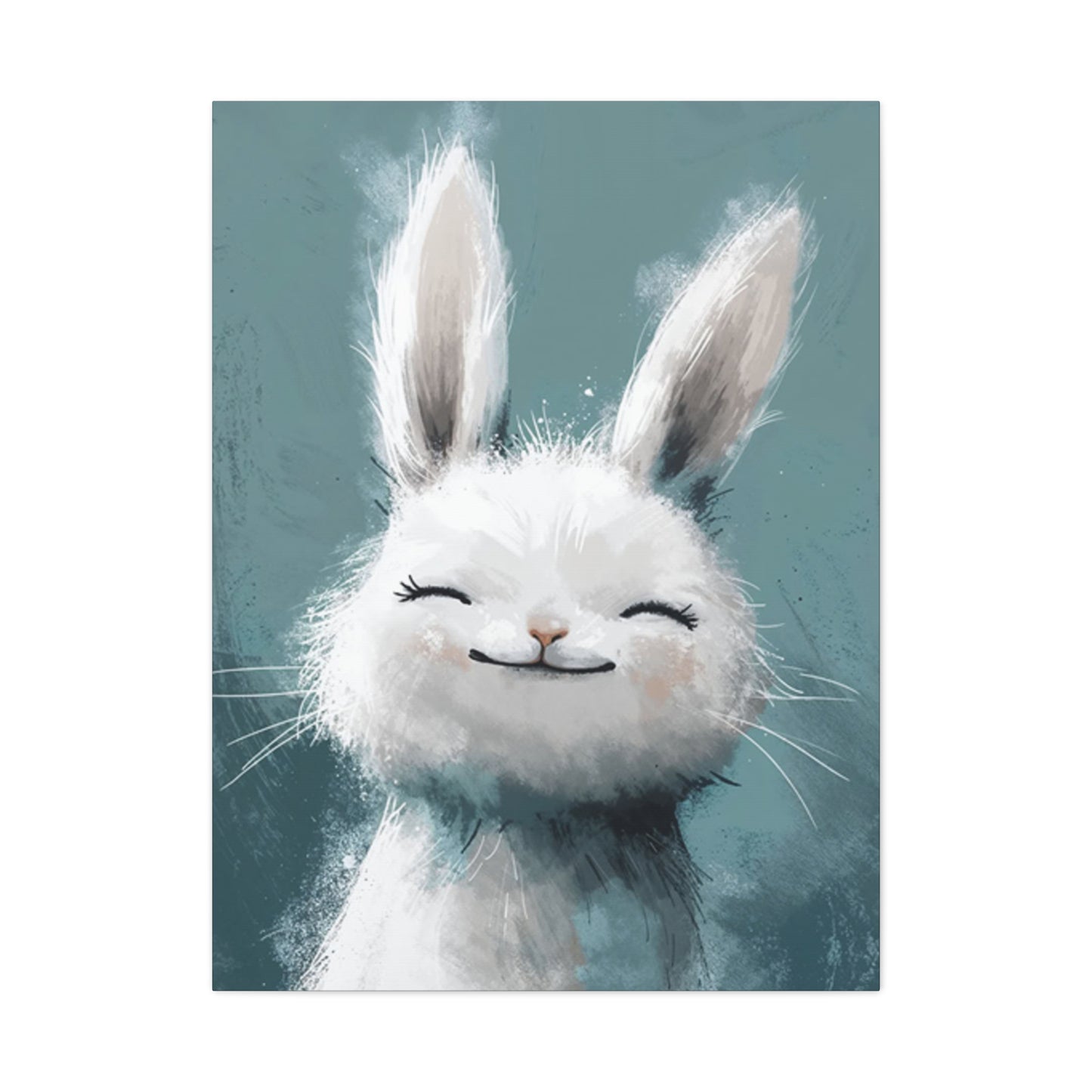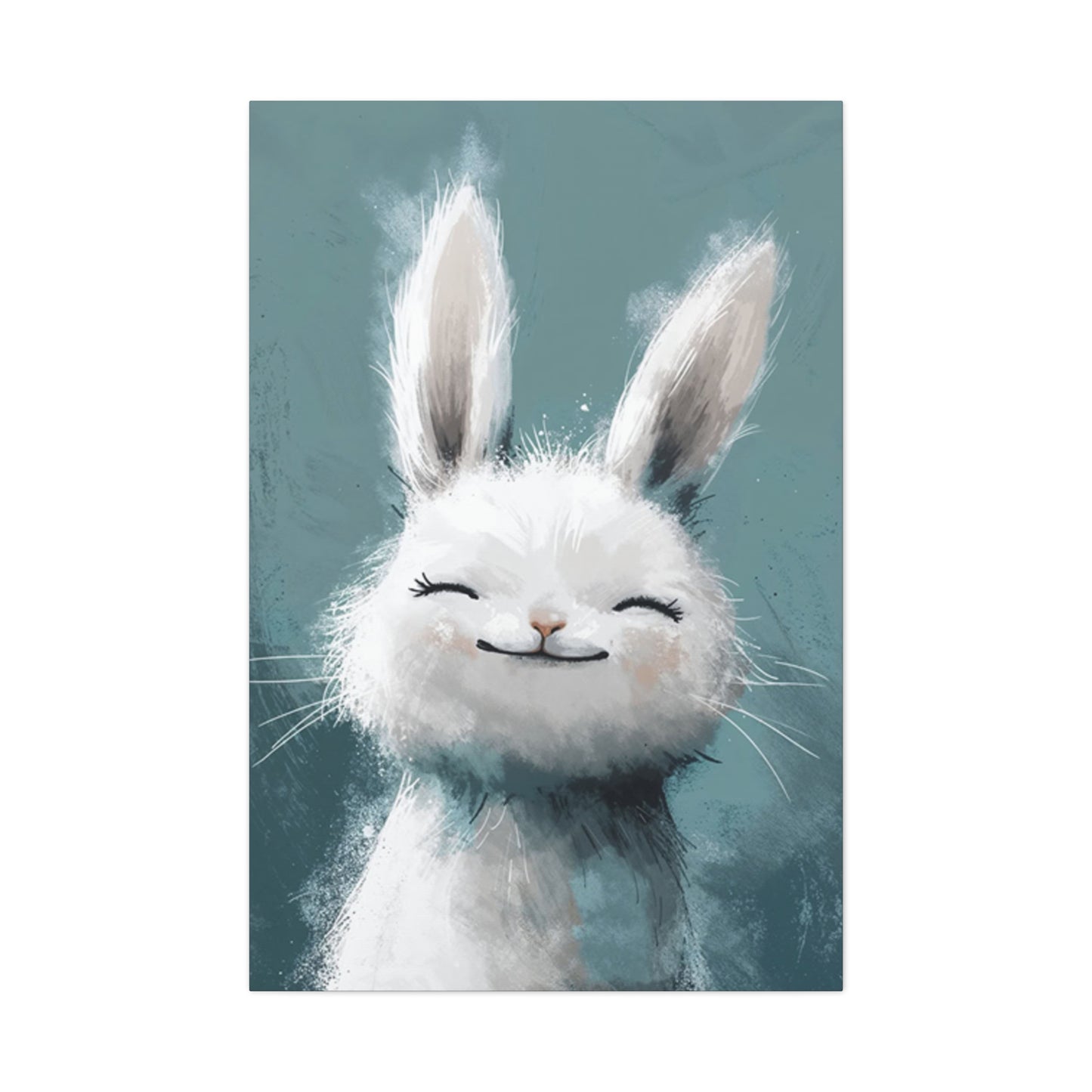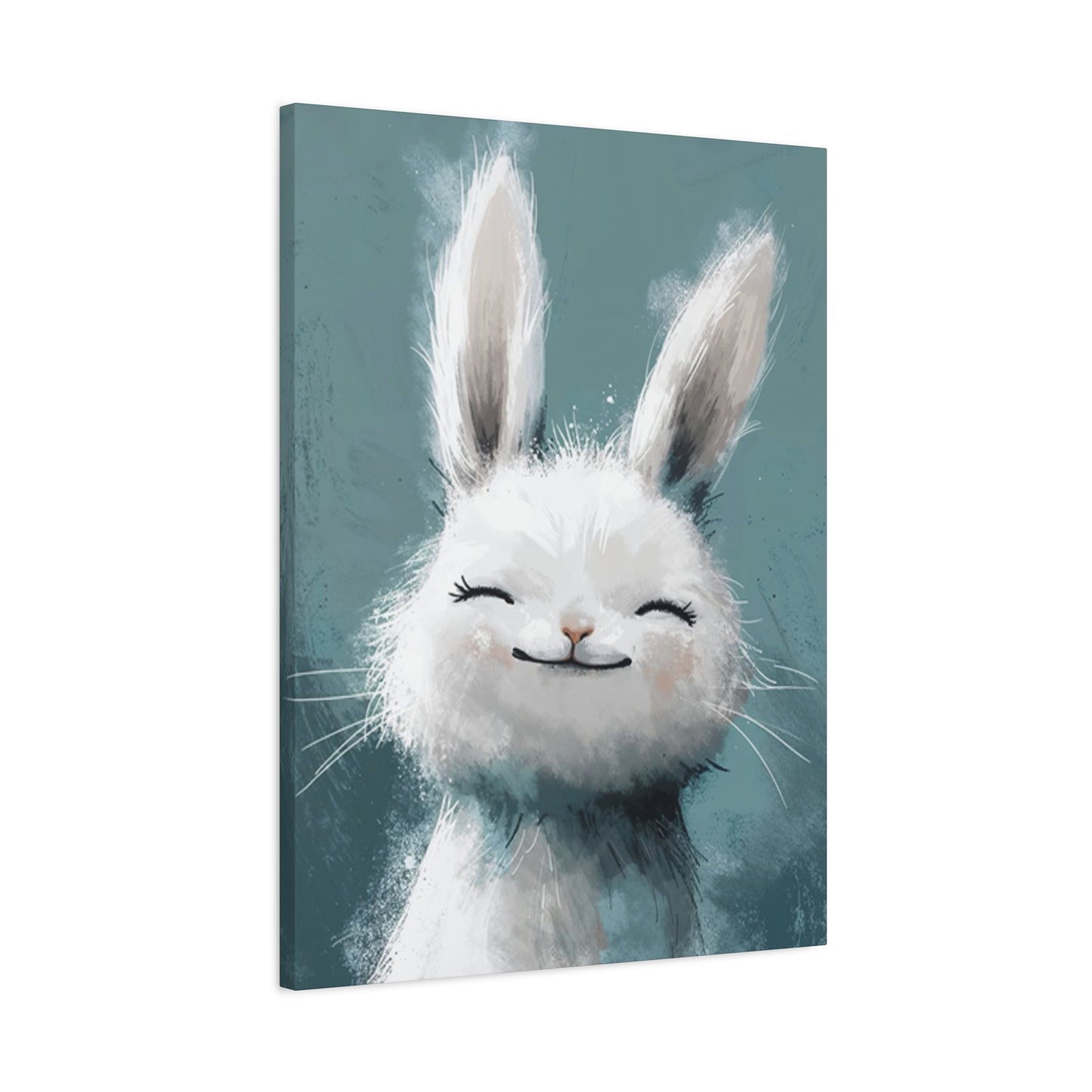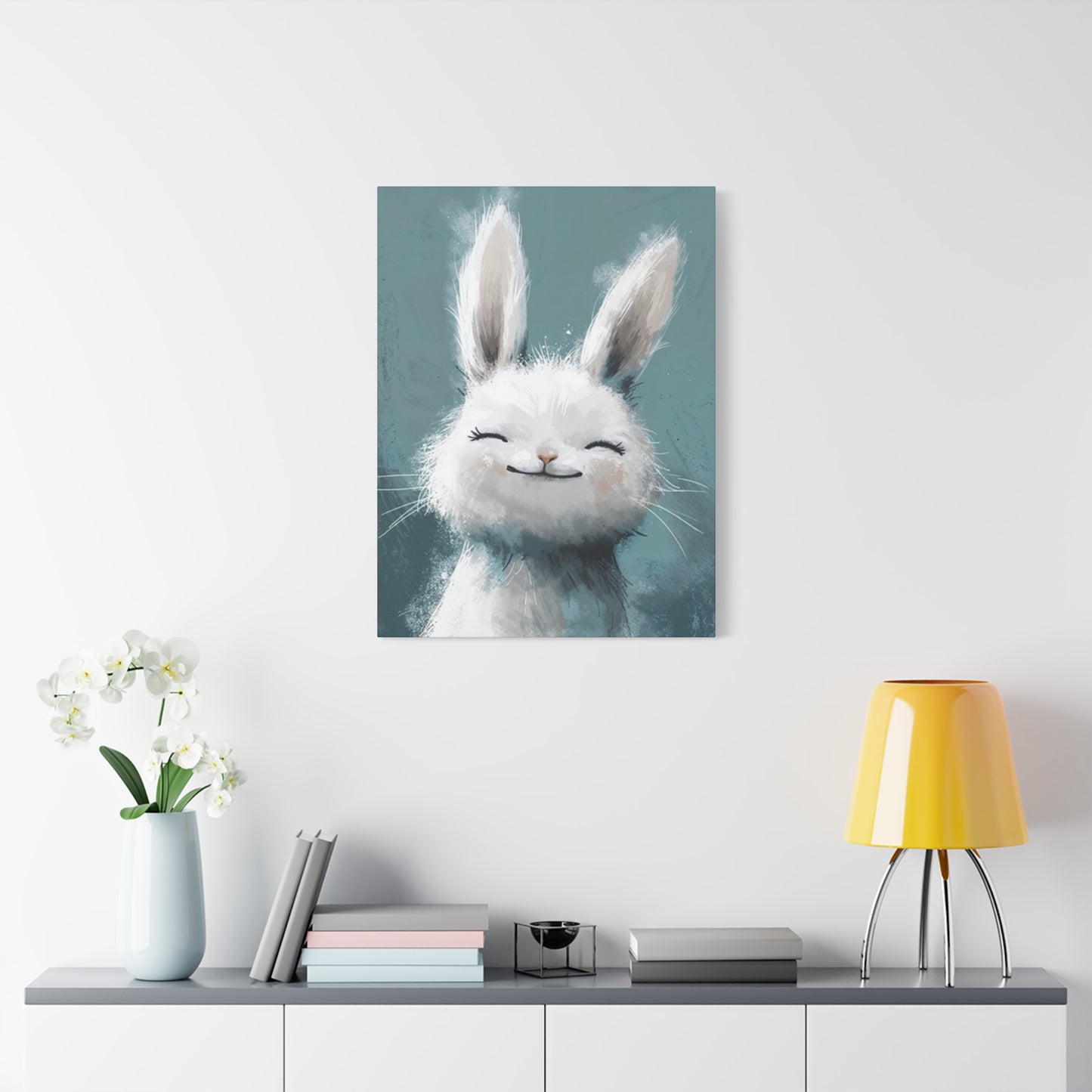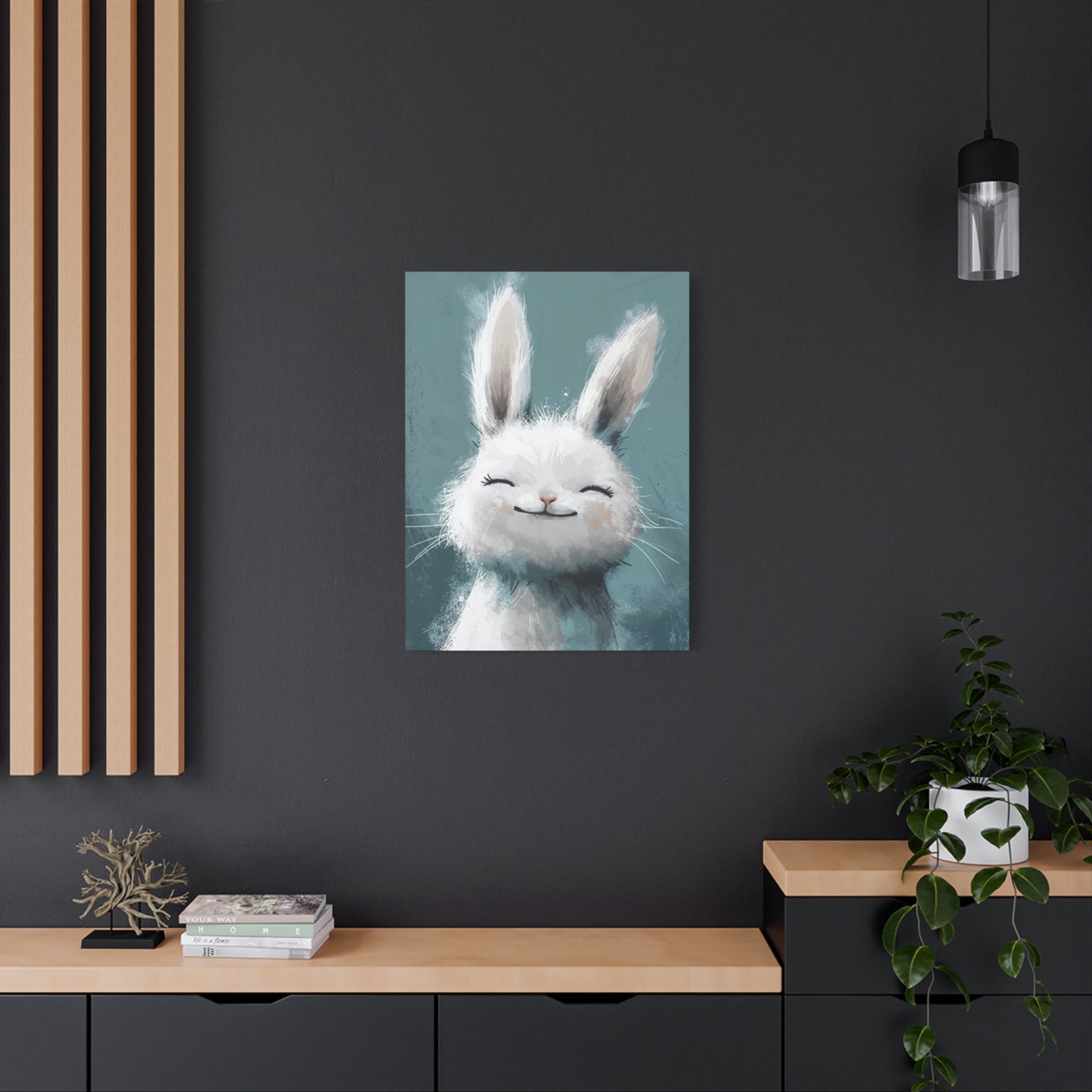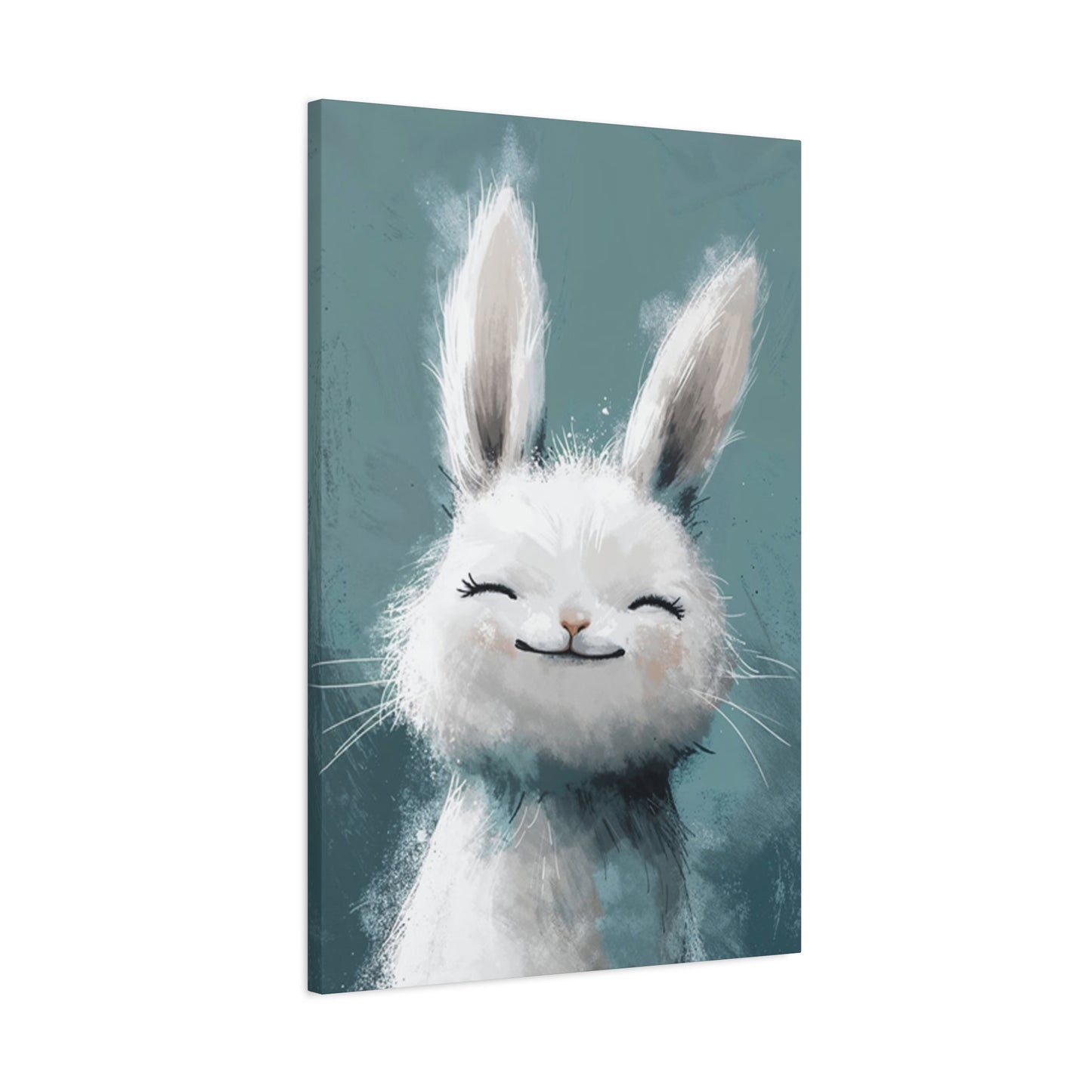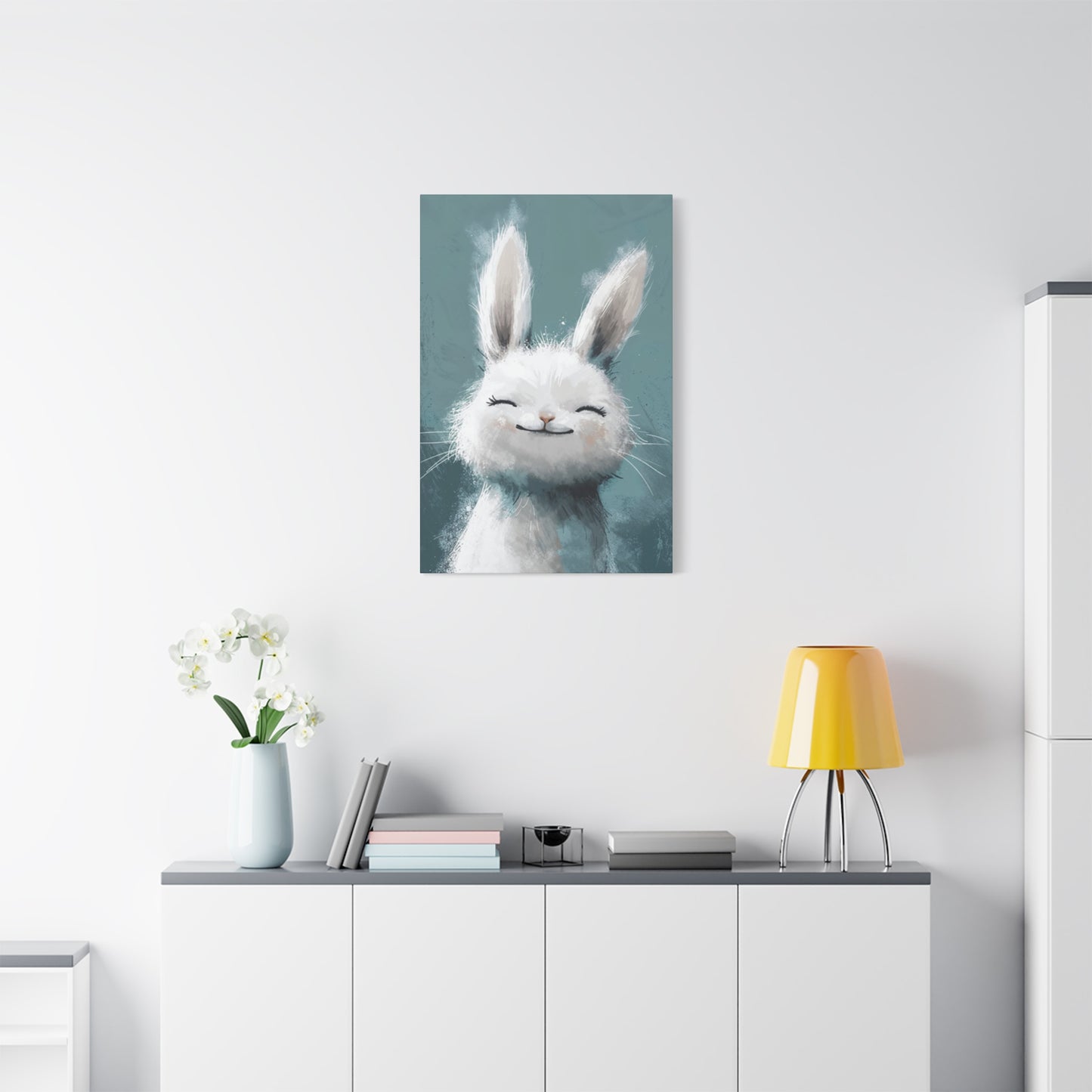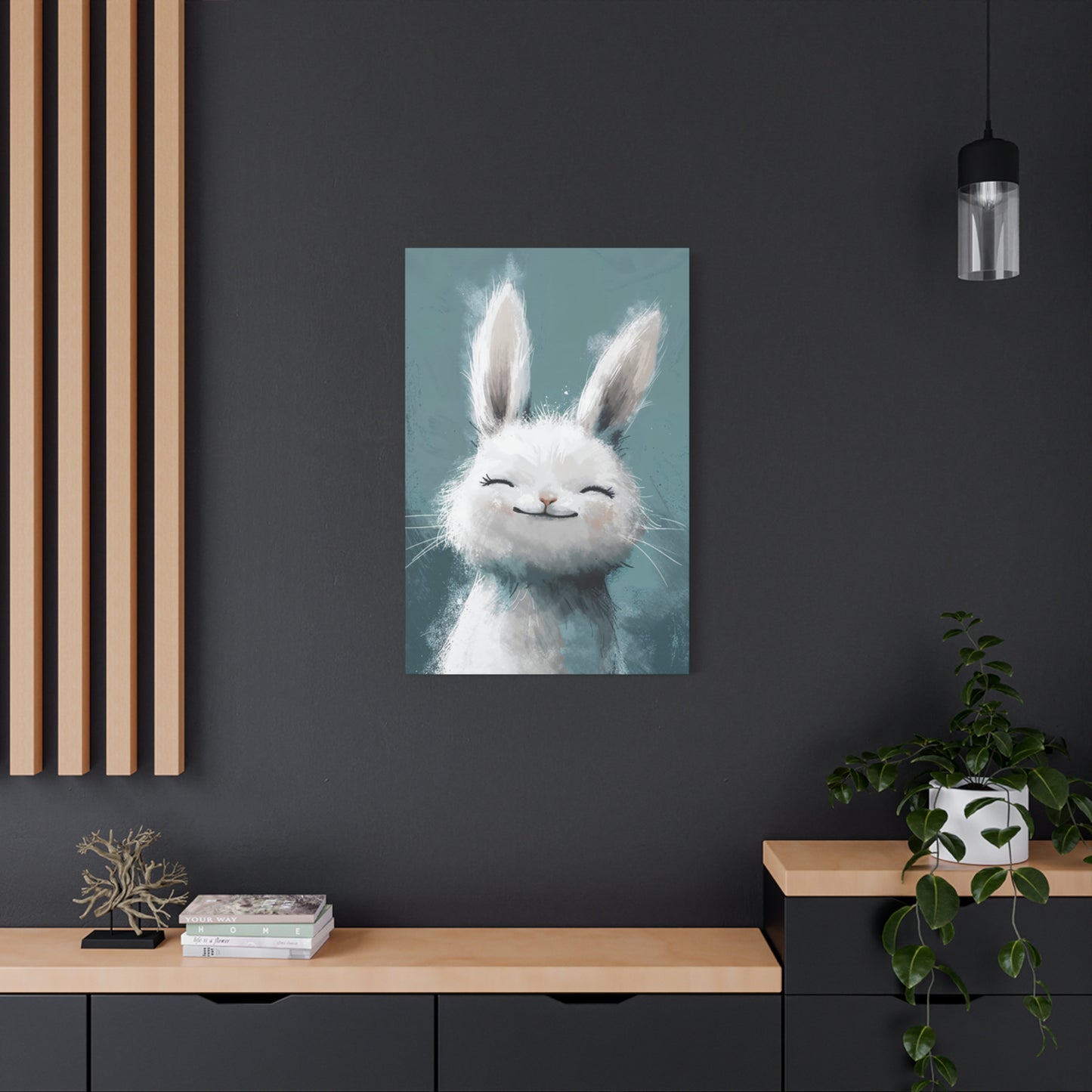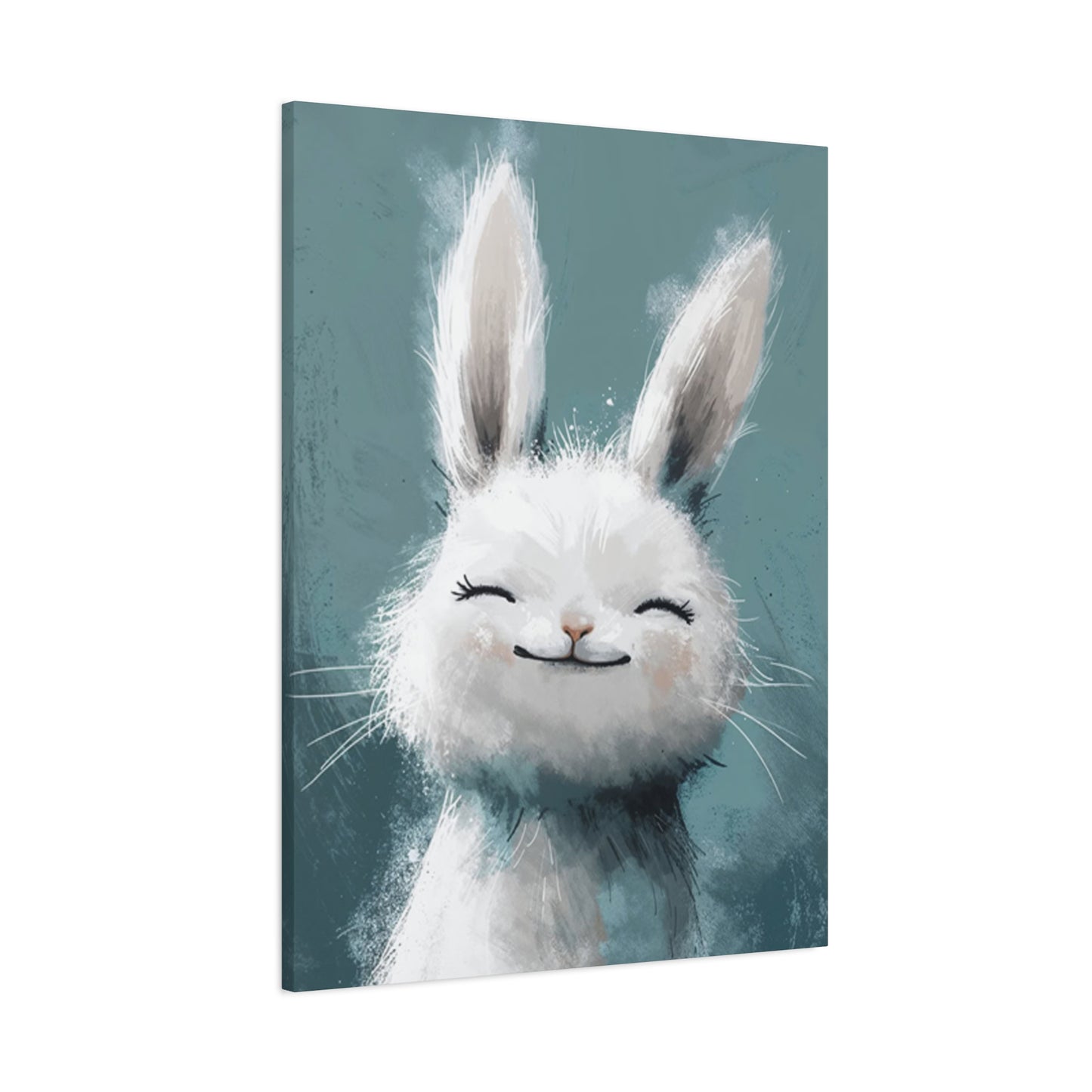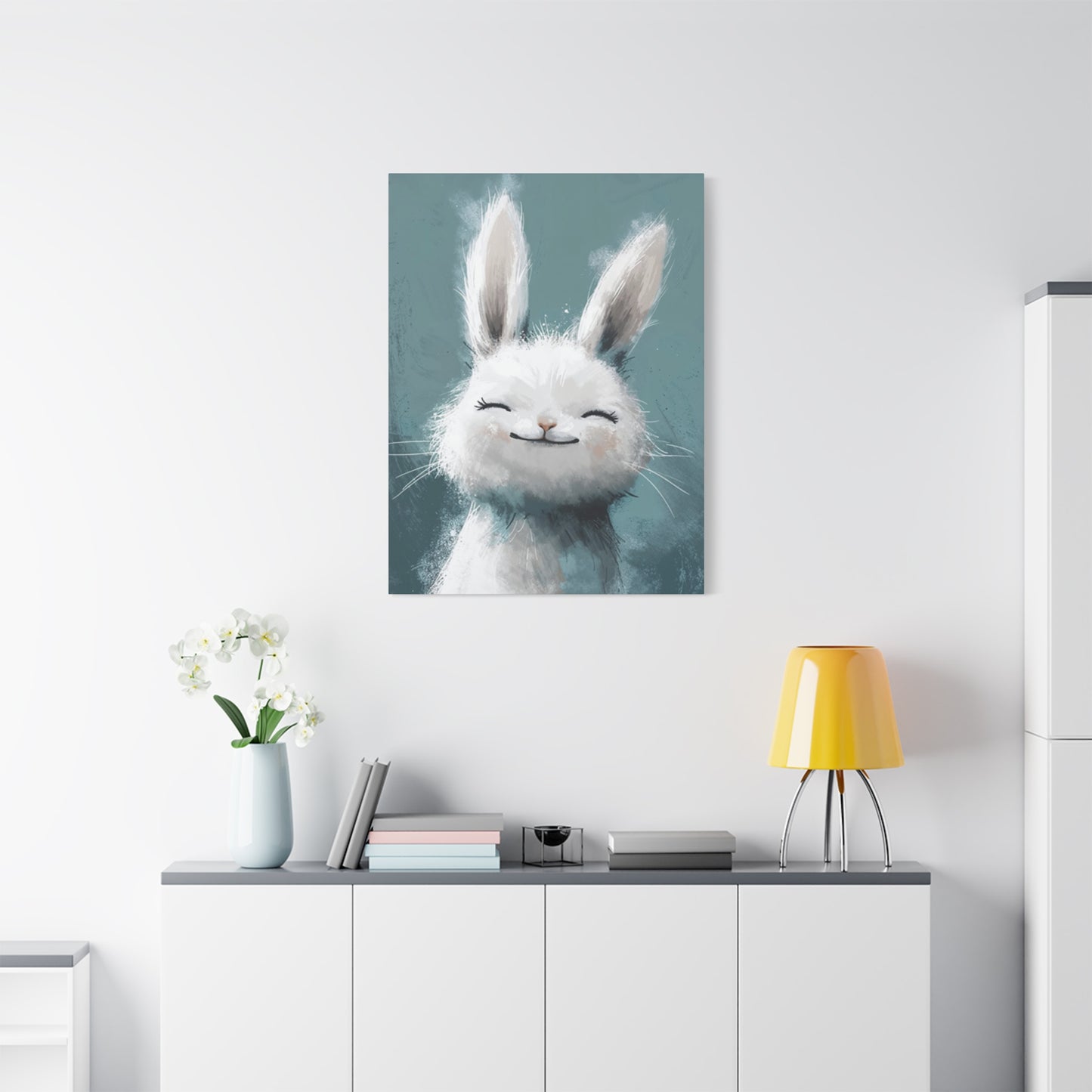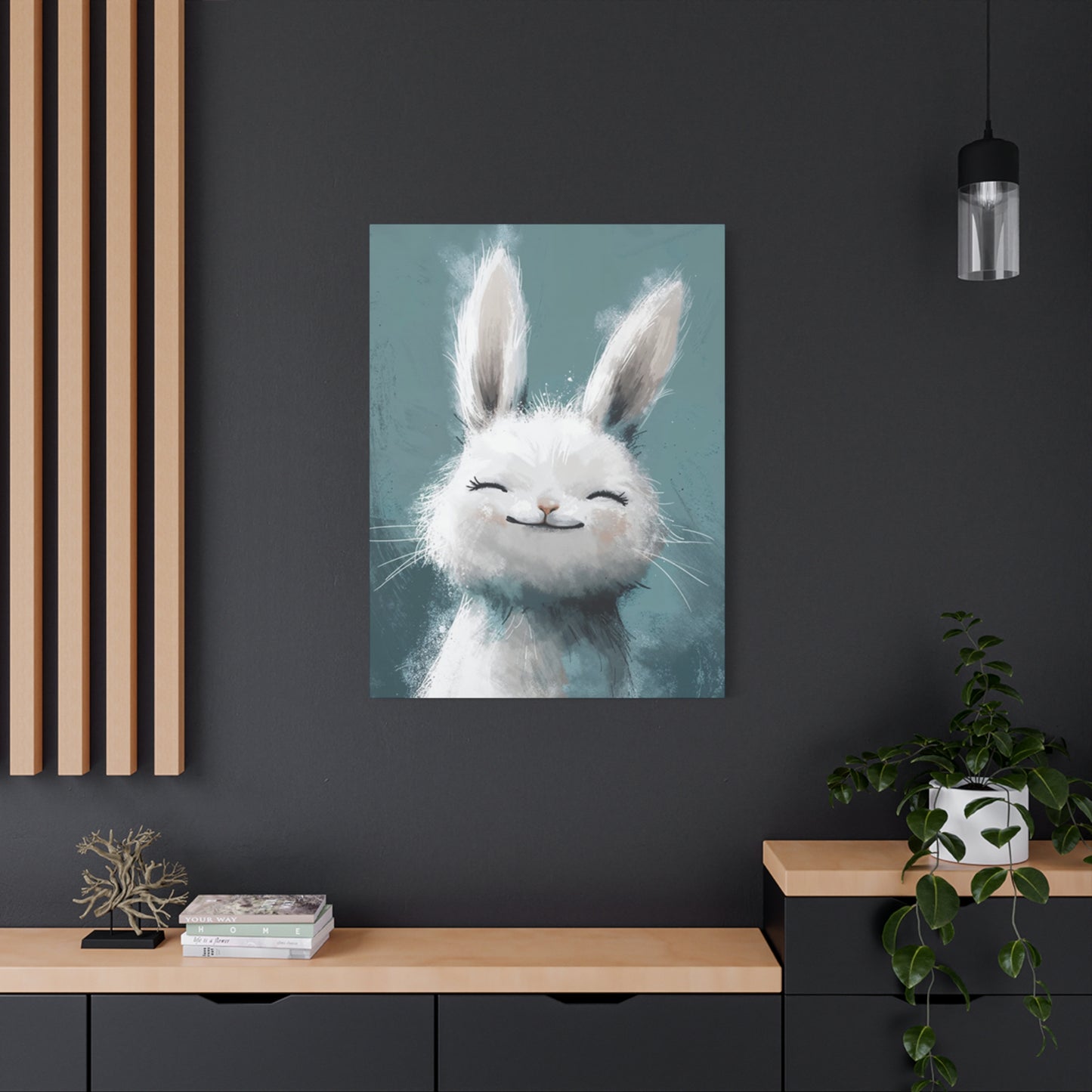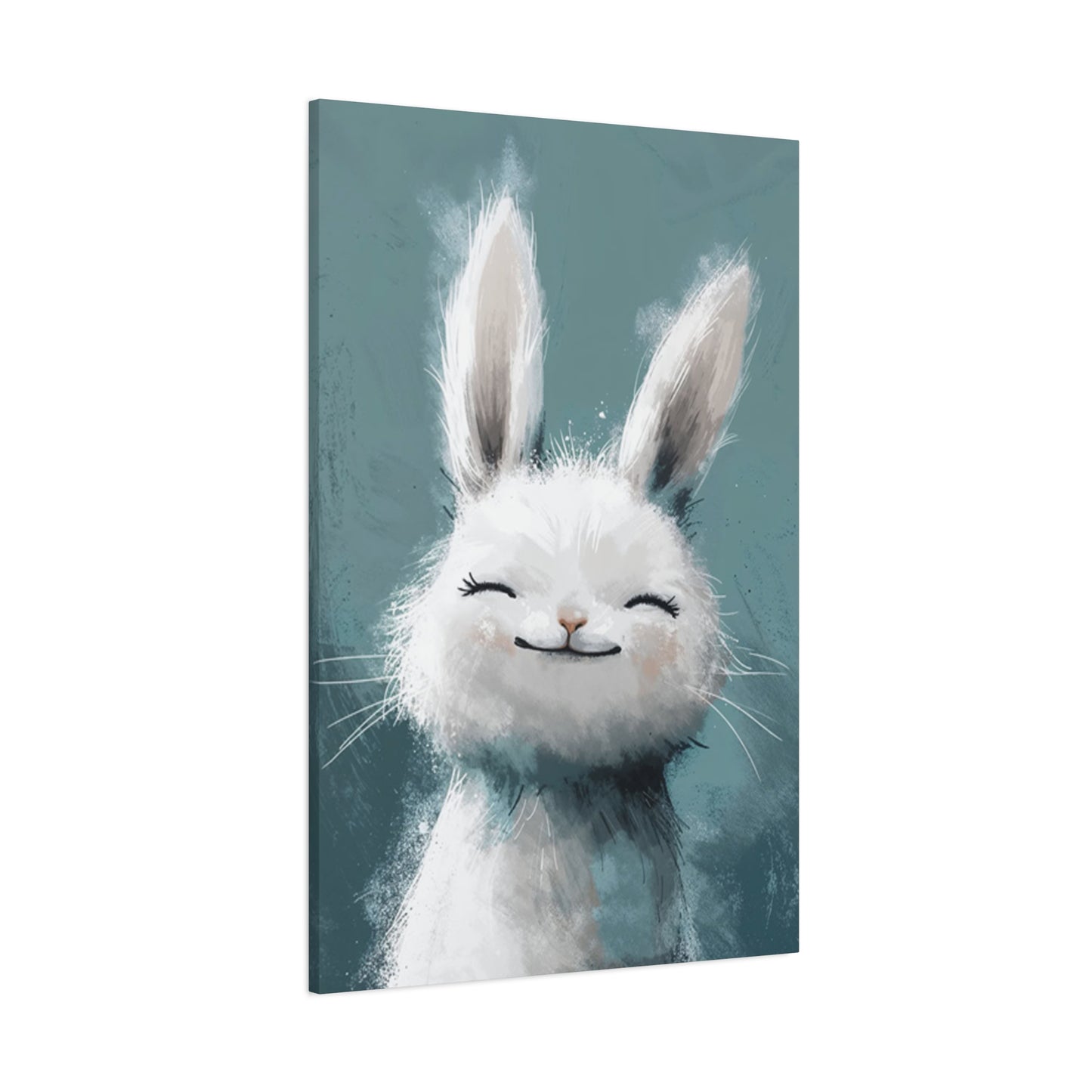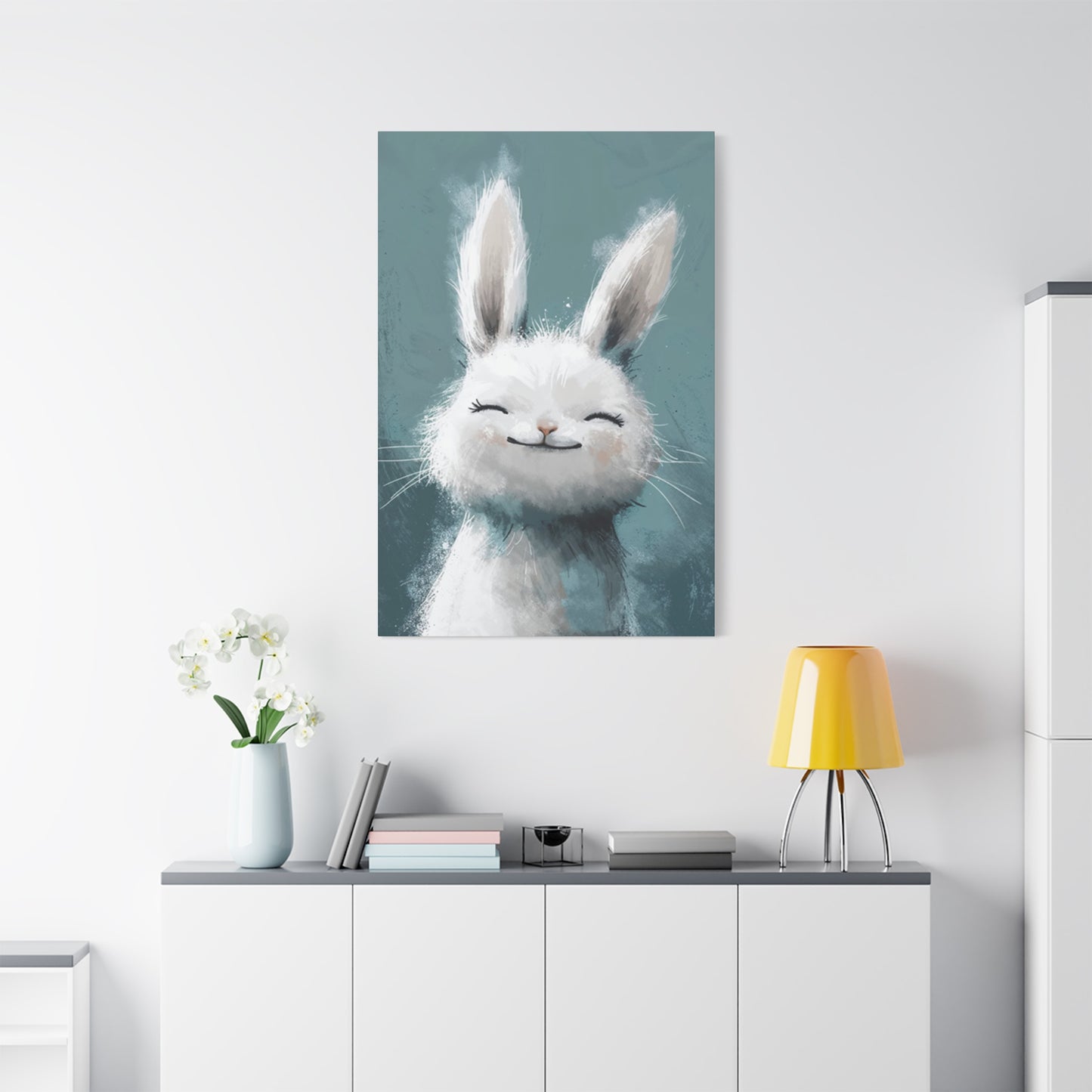Captivating Charm: Exploring the Allure of the Small White Bunny Wall Art Phenomenon
The intersection of fine art and accessible home decoration is a fascinating space, and few motifs hold a position as surprisingly prominent yet universally adored as the small white bunny in wall art. This seemingly simple subject transcends its humble zoological origins to become a potent symbol within interior design, psychology, and cultural iconography. The choice of the word "small" is not accidental; it suggests a certain intimacy, a subtle presence rather than an overwhelming statement, aligning with modern design trends that prioritize comfort, personal narrative, and understated elegance. The "white" hue further amplifies this effect, conveying purity, innocence, and a remarkable versatility that allows the piece to harmoniously integrate into virtually any color scheme or aesthetic, from the stark minimalism of Scandinavian design to the layered texture of a rustic farmhouse style. This widespread appeal is the secret to its success. It is an image that speaks a silent, gentle language—a visual shorthand for tranquility, new beginnings, and soft, childlike wonder.
The enduring allure of this particular piece of art is not merely a matter of cute aesthetics; it is a deep-seated response to a universally recognized symbol of vulnerability and peacefulness. We are drawn to it because it offers a visual escape, a small, quiet moment of respite captured within a frame, acting as a counterbalance to the often-chaotic visual environment of contemporary life. The act of selecting and displaying such a piece is an intentional choice to invite softness and a sense of calm into a personal space. This comprehensive exploration delves into the multifaceted reasons behind its pervasive popularity, dissecting its cultural significance, examining its technical execution across various media, and analyzing its powerful yet subtle role in shaping the emotional atmosphere of our living environments. The subsequent sections will meticulously unpack the layers of meaning, material, and market dynamics that converge to make the small white bunny wall art a truly captivating and enduring phenomenon in the world of decor.
The Profound Cultural and Historical Symbolism of the Rabbit
To fully appreciate the impact of the small white bunny as a subject in wall art, one must first journey into the deep well of cultural and historical symbolism attached to the rabbit and hare across global civilizations. The creature is far more than an agricultural pest or a woodland animal; it is a powerful archetype woven into the very fabric of human mythology, folklore, and religious thought for millennia. In virtually every tradition, the rabbit is a creature of duality and complex meaning. Its most famous association is with fertility and abundance, stemming from its well-known prolific reproductive cycle. This primary symbolism is why it became central to ancient spring festivals and, subsequently, the modern Easter tradition, where the white bunny, specifically, represents the renewal of life, innocence, and the transition from winter to spring.
The choice of white in art is critical here; it strips the rabbit of any earthiness and elevates it to a spiritual or ethereal plane, symbolizing purity, peace, and often, an otherworldly wisdom. Beyond fertility, the rabbit is also a significant lunar symbol in various Asian and Mesoamerican cultures, often depicted pounding herbs for immortality—the mythical "Jade Rabbit" residing on the moon. This link to the moon imbues the artistic depiction with qualities of mystery, intuition, and the cyclical nature of time. In Celtic and Nordic traditions, the hare, a close relative, was often associated with shape-shifting deities and magic, lending the creature an air of powerful, mystical energy. Even in more contemporary psychology, the rabbit often surfaces as a symbol of timidity or vulnerability, which paradoxically enhances its appeal in art—it elicits a protective, nurturing response from the viewer.
When translated into wall art, these ancient, embedded meanings are unconsciously activated in the observer. The small white bunny is therefore not just a depiction of an animal; it is a carefully curated symbol that carries the weight of history—a talisman of good fortune, a beacon of peace, and a quiet nod to the powerful, enduring forces of nature and renewal. The deliberate inclusion of these subtle, multi-layered associations is what elevates the art from simple decoration to a piece imbued with a resonant, symbolic depth that quietly enhances the atmosphere of any room. This foundational symbolic understanding is key to grasping the expansive scope required to achieve a comprehensive article on this topic.
Soft Imagery in Domestic Spaces
The integration of the small white bunny wall art into a domestic setting is a subtle yet powerful act of psychological landscaping. The human brain is constantly processing the visual environment, and the imagery we choose to surround ourselves with plays a critical role in regulating our mood, stress levels, and cognitive state. The specific aesthetic qualities inherent in the depiction of a small white bunny—soft lines, gentle textures, a high-key color palette dominated by white and muted tones—are scientifically proven to evoke a state of calm and psychological comfort. This effect is rooted in our innate biophilia, the deep-seated human tendency to seek connections with nature and other forms of life.
Images of small, non-threatening, and nurturing subjects, particularly those representing innocence, act as visual anchors for a parasympathetic nervous system response—the "rest and digest" mode—reducing heart rate and promoting a feeling of security. The color white itself is crucial; in color psychology, it is associated with cleanliness, simplicity, and a lack of visual clutter, offering a cognitive break from the oversaturation of information and color found in the outside world. Furthermore, the theme often taps into a potent sense of nostalgia, subtly reminding the viewer of childhood innocence, fairy tales, and a simpler time, creating an emotional resonance that is highly therapeutic. It is a form of self-soothing decor.
Unlike powerful, dramatic, or abstract art that might demand intense intellectual engagement or emotional confrontation, the small white bunny wall art simply offers an affirmation of gentleness. It functions as a non-stressful visual element, making it an ideal choice for high-traffic or high-stress areas of the home, such as bedrooms, nurseries, or home offices. In the context of modern interior design, where the home is increasingly seen as a sanctuary, this type of soft imagery serves a vital function, transforming a mere structure into a refuge that actively supports mental well-being and emotional equilibrium. The intentional cultivation of a serene environment through such artistic choices is a testament to the profound connection between visual stimuli and psychological health, making the art piece not just decorative, but functionally beneficial.
Integrating the Motif into Diverse Interior Design Aesthetics
The versatility of the small white bunny wall art is arguably its most significant attribute in the context of contemporary interior design, allowing it to move seamlessly across a vast spectrum of aesthetic styles. Its neutral color scheme and inherently gentle subject matter provide a stylistic chameleon that can be adapted and reinterpreted by designers and homeowners alike. For instance, in a Minimalist or Scandinavian (Scandi) interior, characterized by clean lines, functional furniture, and a monochromatic palette, a framed photographic or line-drawing rendition of the white bunny acts as a necessary, soft organic counterpoint. It introduces a touch of warmth and personality without breaking the strict rule of simplicity, often rendered in a black or natural wood frame to maintain the design integrity.
Conversely, when integrated into a Rustic Farmhouse style, the image often takes on a more textural quality, perhaps printed on canvas or distressed wood, and paired with a reclaimed wood frame. Here, it complements the style's emphasis on nature, coziness, and homespun charm, fitting perfectly with other natural materials like linen, exposed beams, and woven baskets. In a more Eclectic or Bohemian setting, the bunny motif might be layered with other vibrant prints and textures, providing a quiet, grounding element amidst a riot of color and pattern. Its purity of color prevents the overall arrangement from becoming visually overwhelming. Furthermore, in Traditional or Classic interiors, the bunny often appears in a more formal, illustrative, or even watercolor style, framed with an ornate gilt or silver frame, lending a touch of refined, whimsical aristocracy reminiscent of Beatrix Potter illustrations.
The key to its universal adaptability lies in the small size and the white color, which ensures it never dominates a space but always contributes a layer of sophisticated visual interest. Designers utilize the rabbit's gentle contour and neutral tone as a "bridge element," a piece that successfully connects disparate color schemes or material textures within a single room, creating a cohesive and harmonious atmosphere. This remarkable capacity to enhance and adapt to radically different design philosophies solidifies its status not as a passing trend, but as a foundational, enduring decorative element.
l Artistry and Media Choices in Execution
The creation of the small white bunny wall art involves a fascinating variety of technical processes and artistic media, each choice fundamentally altering the final aesthetic and emotional impact of the piece. The medium selected is not merely a vehicle for the image; it is an intrinsic part of the art’s message, influencing light refraction, texture, and durability. Watercolor, for example, is a highly popular medium for this subject due to its inherent translucency and soft, bleeding edges, which perfectly capture the ephemeral, gentle nature of the bunny. The delicate washes of color create a dreamy, light-filled atmosphere, making the final piece feel airy and almost weightless, ideal for nurseries or bright, peaceful living areas. In contrast, a Fine-Art Photography rendition might capture the sharp detail of the bunny's fur an
d whiskers, creating a hyper-realistic, often intimate portrayal that connects the viewer directly to the animal in a moment of quiet observation. This medium emphasizes the natural beauty and texture, often rendered in high-contrast black and white to heighten the drama and focus solely on form and light. Digital Illustration and Vector Art offer a different, highly contemporary approach, allowing for perfectly clean lines, flat blocks of pure white, and a geometric simplicity that aligns well with modern graphic design principles. This type of execution often abstracts the rabbit’s form slightly, making it more symbolic and less literal, a favorite for modern, minimalist offices and urban apartments.
Furthermore, the choice of substrate is equally important. Printing on textured archival paper adds a tactile dimension, while printing on canvas gives the appearance of an original oil painting, lending a depth and heft to the image. Even the choice between matte and glossy finish fundamentally changes how light interacts with the white of the bunny's fur, affecting the overall mood. Artists must also grapple with the complex challenge of representing white on white—rendering the form of the white bunny using subtle shades of shadow, slight color shifts (creams, grays, barely-there blues), and masterful control over negative space to define the edges without resorting to stark outlines. This technical finesse is what distinguishes a truly compelling piece of art from a simple illustration, elevating the common motif to a level of sophisticated artistic expression.
The Rabbit as a Universal Cultural Archetype
To fully comprehend the deep, resonant connection people feel to the small white bunny wall art, one must journey through the vast, interwoven history of rabbit and hare symbolism across global mythologies. The creature is not a blank slate; it is a profound archetype rich with ancient, often paradoxical meanings that unconsciously inform the viewer's emotional response. The most ancient and widespread association is with fertility, vitality, and the regenerative power of spring, rooted in the creature's famously prolific breeding cycle. This powerful link to life's renewal is why the white bunny became a central, enduring figure in spring rites, eventually evolving into the modern Easter iconography, where the color white further underscores themes of purity and rebirth. Beyond the terrestrial, the rabbit holds a pivotal celestial role, notably in Asian folklore.
The mythical "Jade Rabbit" of Chinese, Korean, and Japanese traditions, perpetually pounding the elixir of immortality on the moon for the goddess Chang'e, transforms the rabbit into a symbol of longevity, compassion, and mystical wisdom. This lunar connection imbues the art piece with a sense of intuition and the cyclical nature of time. Conversely, in certain European and Native American narratives, the rabbit is a celebrated trickster figure—agile, cunning, and quick-witted—representing mental agility and the ability to navigate complex challenges swiftly. Even the perceived timidity of the creature contributes to its artistic power; this vulnerability fosters a protective and empathetic response from the observer, making the art piece feel nurturing. Therefore, when a homeowner selects this piece of art, they are inadvertently inviting centuries of embedded human belief—a talisman of luck, a beacon of peace, and a subtle acknowledgment of the powerful, yet delicate, forces of nature.
The Neuro-Aesthetics of Innocence: Psychological Comfort in Art
The decision to place a depiction of a small white bunny wall art within a living space is a direct, albeit often unconscious, application of neuro-aesthetics, the study of how art affects the brain. The visual characteristics inherent in this motif are masterfully engineered to promote a state of psychological comfort and reduce cognitive load. The soft edges, gentle curvatures, and overall high-key, bright composition—dominated by the soothing neutrality of white—act as a visual antidote to the overstimulation prevalent in contemporary life. Psychologically, images of small, non-threatening animals trigger an innate human response rooted in biophilia, our tendency to connect with nature. This connection is restorative, signaling safety and promoting the activation of the parasympathetic nervous system, which governs the "rest and digest" state.
This reaction effectively lowers stress hormones, stabilizes heart rate, and fosters a sense of inner peace. Furthermore, the rabbit's common association with childhood literature and fairy tales—figures like Peter Rabbit or the White Rabbit from Wonderland—taps into a deep vein of nostalgia. This emotional recall is highly therapeutic, linking the domestic space to feelings of security, simplicity, and innocent wonder. The art piece serves as a visual sanctuary, a point of focus that is entirely non-confrontational and non-demanding. Unlike complex abstract pieces that require intellectual deconstruction or dramatic landscapes that evoke powerful, sometimes challenging emotions, the white bunny offers unconditional visual affirmation. It is a source of gentle, immediate visual pleasure, making it uniquely suited for areas designed for repose and mental clarity, such as nurseries, reading nooks, or bedrooms, solidifying its function not merely as decoration, but as an active component of a holistic, emotionally supportive domestic environment.
Anatomy of Artistic Versatility: Adapting the Motif to Design Styles
The unparalleled success of the small white bunny wall art in the competitive world of home decor is largely attributable to its chameleon-like ability to conform to, and elevate, an extraordinary range of interior design styles. The inherent neutrality of its color and the organic, non-geometric form of the subject provide a design foundation that resists being typecast or becoming dated. Consider its integration into a stringent Scandinavian Minimalist space. Here, the rabbit, often rendered in a simple line drawing or a muted watercolor, is framed in a thin, light wood or pure black, providing the essential hygge—a touch of organic warmth and personality—without violating the style's core principles of simplicity and functionality. It adds life without adding clutter. In stark contrast, when applied to a Bohemian or Maximalist setting, the same motif might appear as a mixed-media piece or a layered collage, framed in a heavily textured or vintage frame.
In this context, the white color acts as a necessary visual pause, a small zone of calm amidst the vibrant chaos of patterns and colors, grounding the overall eclectic arrangement. For the refined elegance of a Transitional or Traditional home, the bunny often takes on a more classic illustration style, reminiscent of early twentieth-century children's books, perhaps printed on thick, creamy archival paper and enclosed in an antique gold or silver-leaf frame, providing a touch of sophisticated, whimsical accent that softens the formality of the furnishings. The motif’s small scale is key to this adaptability; it never dictates the room's design but rather serves as a carefully chosen, high-impact accent. It functions as a unifier, capable of connecting disparate colors or textures across the room, ensuring that the piece remains a timeless, stylistically agnostic element that contributes harmony regardless of the prevailing aesthetic.
The Technical Craft: Media Choices and the Rendering of White
The creation of compelling small white bunny wall art is a technical exercise in subtle brilliance, demanding specific mastery over various artistic media and the notoriously difficult task of representing a white subject against a light background. Each medium choice fundamentally alters the piece's texture, light quality, and final mood. Watercolor is frequently chosen for its inherent ability to create softness and transparency. The artist must rely on the white of the paper itself to represent the white fur, using extremely diluted washes of cream, pale gray, or blue only to delineate shadow and form. This technique results in an ethereal, light-filled quality that perfectly matches the subject's gentle nature, often lending itself to a dreamy, non-realistic aesthetic ideal for serene spaces. Conversely, a Linocut or Engraving emphasizes the graphic quality of the subject. The final image relies on stark black lines against the negative white space, focusing intensely on the silhouette and contour.
This method produces a piece that is sharp, modern, and highly structural, aligning with more contemporary or industrial interior designs. In the realm of Photography, the artist focuses on capturing hyper-realistic texture. Success relies on precise lighting to reveal the minute details of the fur using micro-shadows, often resulting in a high-contrast black and white print that focuses purely on form and the delicate play of light across the small rabbit's shape. Furthermore, modern Digital Illustration offers the ability to create flat, vectorized white shapes with perfect, clean edges. This style is often highly abstract or geometric, reducing the rabbit to its most essential lines and forms, appealing directly to the minimalist sensibility. The central challenge across all these media is the effective use of negative space—the white area surrounding the bunny—which an experienced artist manipulates to give the subject shape, depth, and a sense of breathing room, ensuring the art piece is not merely an illustration but a sophisticated study of light, form, and quiet presence.
Framing as Final Artistry: Enhancing the Narrative of the Print
The ultimate presentation of the small white bunny wall art is inseparable from its framing, which serves as the final, critical layer of artistic and stylistic decision-making, capable of dramatically shifting the emotional register and decorative context of the piece. The frame is the boundary that transitions the image from paper to wall, acting as a visual matting device that enhances the purity of the white subject. In a popular contemporary approach, a thin, natural oak or maple wood frame is used, often without a mat. This choice provides a rustic, organic warmth that complements the natural subject matter, instantly aligning the piece with Scandinavian, Japandi, or Modern Farmhouse aesthetics. The simplicity of the frame ensures the focus remains entirely on the delicate detail of the small rabbit. For a more classic or formal presentation, a wide, ivory or cream mat is often paired with a subtle, antique gold or silver-leaf frame.
The mat provides generous white space that pushes the image deeper into the frame, creating a sense of preciousness and traditional gallery quality, which is ideal for classic, transitional, or cottage styles. A modern, dramatic statement might utilize a deep-set shadow box frame in matte black. This stark, bold choice provides a strong contrast against the white art, giving the piece a graphic, almost three-dimensional presence that suits industrial or high-contrast modern interiors. The frame's material and color also dictate how the art interacts with its neighboring decor. A simple metal frame in brass might tie the artwork to other brass hardware in the room, while a distressed barn wood frame connects it to rustic wooden furniture. Ultimately, the careful selection of framing material, color, and depth is the designer's final opportunity to either underscore the existing aesthetic or to introduce a calculated tension, transforming the small artwork into a powerful, perfectly tailored element of the overall interior narrative.
Market Dynamics: The Commercial Success of a Gentle Motif
The commercial triumph of the small white bunny wall art is a remarkable case study in how simple, universally appealing imagery can capture a significant share of the global home decor market. Its success is rooted in two key factors: extreme visual versatility and powerful emotional branding. Unlike complex, niche art, the rabbit motif carries a minimal barrier to entry; its inherent innocence and non-controversial nature make it an immediate and safe purchasing decision for a wide demographic, from parents decorating nurseries to adults seeking subtle, sophisticated accents for living rooms or home offices. This broad appeal allows it to be successfully mass-produced across all price points, from affordable digital prints to high-end, limited-edition original watercolors, making the motif financially accessible to virtually every consumer segment.
Crucially, the theme benefits heavily from cyclical consumer trends, particularly the enduring popularity of cottagecore and the relentless growth of the wellness-focused home movement, where the demand for nature-inspired, soothing imagery is consistently high. Retailers and designers capitalize on the associated keywords—whimsical, nursery, minimalist animal art, and gentle decor—driving massive SEO value and digital traffic. The subject's ease of reproduction across various substrates, including canvas, archival paper, wood planks, and metal, further minimizes production costs while maximizing market saturation. This commercial flexibility, coupled with the motif's deep-seated cultural and psychological resonance, has solidified the white bunny as a bankable, low-risk investment for art manufacturers and decorators, turning a simple sketch of an animal into a multi-million-dollar global decorative phenomenon that continues to expand its reach.
The White Rabbit in Literature: Guiding Narratives and Symbolism
The cultural ubiquity and depth of the small white bunny wall art cannot be fully appreciated without acknowledging the profound impact of literary representations, which have cemented the white rabbit as a powerful narrative guide and symbol in the collective imagination. Chief among these is Lewis Carroll’s iconic White Rabbit from Alice’s Adventures in Wonderland. This figure, perpetually late and anxiously checking his watch, serves as the frantic, time-obsessed catalyst for Alice's fantastical journey into the unknown. In this context, the white bunny represents the call to adventure, the allure of the unconscious mind, and the chaotic nature of time and destiny. Hanging this art piece subtly taps into this literary theme, suggesting a willingness to embrace whimsical escapism and a gentle challenge to the rigid structure of everyday life.
Equally important are the works of Beatrix Potter, where figures like Peter Rabbit embody mischievous curiosity, gentle rebellion, and the vulnerabilities of childhood. Potter's illustrations, often rendered in soft, delicate watercolors, established the aesthetic template for the gentle animal art style that the modern wall art frequently emulates. Furthermore, the rabbit has been utilized in sophisticated adult fiction as a symbol of fragility, hidden knowledge, or even spiritual quest, as seen in works exploring folklore and myth. The constant exposure to these literary figures, from childhood onwards, ensures that the art piece is always viewed through a filter of established emotional and thematic complexity. The small white bunny is therefore not just a representation of an animal; it is a visual echo of universal stories about growth, discovery, and the delicate balance between the domestic world and the untamed imagination.
Pediatric Design: The Bunny Motif in Nursery and Children's Spaces
The small white bunny wall art holds a particularly revered and logical position within the world of pediatric and nursery design, where its characteristics align perfectly with the developmental and aesthetic needs of the space. The dominance of white and neutral tones in the motif is highly functional, providing a calming visual environment that avoids the overstimulation often associated with brightly colored children's decor. This soft palette is intentionally chosen to promote tranquility and aid in the restful atmosphere essential for sleep and early development. Psychologically, the rabbit is a universally accepted, non-threatening creature that evokes a sense of tenderness and safety, making it an ideal first companion figure for a child's visual landscape. Its small scale ensures that the art does not overwhelm the relatively compact space of a nursery.
Design professionals often recommend the white bunny motif for its gender-neutral appeal, offering a sophisticated alternative to traditional, often restrictive, gendered color schemes. This neutrality also allows the art to be easily transitioned and re-used as the child grows and design tastes evolve, giving the decor longevity. The artwork often serves a narrative function for parents, acting as a prompt for stories about nature, kindness, and quiet exploration. Beyond mere aesthetics, the bunny art supports the core principle of early childhood design: creating a visually harmonious environment that supports emotional security and cognitive development through gentle, nature-based imagery, solidifying its status as an enduring classic in the specialized field of children's room decor.
The Fine Line: Distinguishing Whimsy from High Art
A critical examination of the small white bunny wall art necessitates a nuanced discussion about its placement along the spectrum of art, specifically the fine line that separates accessible whimsy from established high art. The motif's simplicity and widespread appeal often lead to its categorization as merely decorative or cutesy, but this assessment overlooks the sophisticated artistic and intellectual decisions involved in its execution and consumption. True high art, regardless of subject, is defined by technical mastery, emotional depth, and its capacity to engage with universal themes. A masterful rendering of the white bunny, achieved through precise control over light, shadow, and negative space (as previously discussed in the technical section), elevates the piece beyond a simple illustration into a study of form and purity, placing it firmly in the realm of fine art printmaking or photography.
Furthermore, when the motif is used to comment on themes of vulnerability, innocence lost, or the fleeting nature of time—as it often is in contemporary, conceptual art—it assumes an intellectual complexity. The distinction rests not on the subject (the bunny) but on the execution and the viewer's intent. A mass-produced graphic print serves a purely decorative function (whimsy), but a limited-edition charcoal sketch of the small rabbit that explores the interplay of darkness and light, framed and presented with curatorial intent, is undeniably engaging with high artistic principles. The motif acts as a versatile canvas, capable of being either a functional accessory or a profound visual statement, with the artist's skill and the consumer's interpretation dictating its final cultural classification.
The Influence of Biophilia: Bringing Tranquility Indoors
The deep-seated appeal of the small white bunny wall art is inextricably linked to the concept of biophilia—the innate human tendency to seek connections with nature and other living systems. In an increasingly urbanized and digitally saturated world, people subconsciously yearn for visual cues that ground them in the natural world. The small white bunny serves as a potent, domesticated form of this biophilic connection. Unlike dramatic landscape art, which can feel vast and distant, the bunny art offers a personal, immediate, and non-threatening piece of nature. It brings the outside in without introducing the chaos or wildness of true wilderness.
The imagery is quiet, clean, and contained, providing the restorative benefits of nature without any accompanying psychological or physical demands. This visual link has a scientifically documented positive impact on mood, reducing mental fatigue and increasing feelings of well-being—a phenomenon known as the Attention Restoration Theory. Placing this type of art in a home or office is an act of design-as-therapy, a conscious effort to leverage the power of natural imagery to create a more supportive and restful environment. The simplicity of the rabbit's form and the soft white color ensure that this biophilic element is introduced gently and subtly, making it highly effective as a tool for creating a truly tranquil and health-supportive interior space.
The Sophistication of an Achromatic Palate
The selection of a white bunny is a deliberate and essential aesthetic choice that exponentially increases the sophistication and decorative utility of the wall art. In color psychology, white is not merely the absence of color but is rich with meaning, symbolizing purity, clarity, simplicity, and new beginnings. For the small white bunny wall art, this achromatic choice offers immense advantages in interior design. Firstly, it functions as a rest area for the eye, providing a zone of visual quiet that is highly prized in modern design, contrasting effectively with any surrounding colors or textures. Secondly, the use of white allows the artist to focus entirely on form and texture.
The visual interest is generated through the subtle rendering of shadows, the direction of the fur's texture, and the shape of the silhouette, requiring a high level of technical proficiency to avoid a flat or dimensionless image. Furthermore, the white bunny is immune to shifting color trends. While accent colors come and go, white remains eternally classic, ensuring the longevity of the art piece in a home's rotating decor. The artwork becomes a masterclass in subtlety, with the bunny's shape defined by the slight differences between the white of the subject, the white of the paper, and the micro-shadows cast by light. This delicate interplay transforms the work into a celebration of light itself, making it a sophisticated, foundational piece for any design focused on elegance and enduring style.
The Architecture of Scale: Why the Word 'Small' Matters
The inclusion of the word "small" in the description of the small white bunny wall art is of profound architectural and decorative significance, transforming the piece from a mere image into a carefully scaled design element. In large-scale interior design, small art pieces serve a crucial function by introducing intimacy and detail where large walls and vast furniture can often create a feeling of coldness or detachment. A small piece demands closer engagement; the viewer must approach it to appreciate the delicate lines and textures. This act of drawing the eye inward creates a focal point of personal connection.
Furthermore, small art is highly effective in gallery wall compositions, where it provides essential visual relief and variety among larger, bolder statements. It acts as a visual punctuation mark. Architecturally, using small pieces allows for greater flexibility in placement—they fit seamlessly above a nightstand, on a shelf vignette, or nestled in a narrow hallway, utilizing often-ignored spaces. In the context of the rabbit, the small scale reinforces the creature's vulnerability and innocence, preventing the image from becoming overly cutesy or childlike, which a large, life-sized rendering might risk. The deliberate choice of "small" maintains an air of sophisticated understatement, ensuring the artwork complements the scale of the room without visually dominating the emotional atmosphere.
Art as Investment: Value, Collectibility, and Limited Editions
The commercial spectrum of the small white bunny wall art extends into the realm of collectibility and investment, particularly when executed as part of a limited-edition series. While mass-produced prints are accessible decorations, pieces created by renowned fine art photographers, illustrators, or printmakers can accrue significant value over time. Key factors that elevate a piece to investment-grade status include the artist's reputation, the print run's exclusivity (e.g., limited edition of 50), the use of archival-grade materials (acid-free paper, pigment-based inks), and the artist's hand-signature and numbering.
A limited-edition white rabbit print acquires value not just as an image, but as an artifact of the artist's unique creative moment. Collectors are often drawn to the motif because it offers a timeless, gentle theme that is less susceptible to the dramatic swings of trend-based abstract or political art. The perceived simplicity of the subject matter, when rendered with extraordinary technical skill, makes the piece particularly resonant for those who value understated beauty and enduring quality. Therefore, a discerning buyer of the small white bunny wall art may not just be decorating a wall; they are engaging in a thoughtful acquisition of a potentially appreciating asset that celebrates a gentle, enduring cultural icon.
The Global Icon: Cultural Adaptations and Iconography
The universal appeal of the small white bunny wall art is reinforced by the creature's adaptable symbolism across disparate global cultures, ensuring its relevance from Asia to the Americas. We have already explored the prominent role of the Jade Rabbit in East Asian lunar mythologies, where its connection to the moon, immortality, and self-sacrifice imbues the image with powerful spiritual significance. This adaptation ensures that a simple white rabbit image resonates deeply within homes that value these philosophical underpinnings. In contrast, the rabbit in many West African and Native American folktales functions as a trickster figure, using cunning and wit to overcome physically stronger opponents.
When viewed through this lens, the art piece can be interpreted as a symbol of intelligence, resilience, and strategic thought, making it a suitable accent for a home office or study. Furthermore, the rabbit's role in Celtic and Germanic traditions as a symbol of fertility and the spring goddess Eostre (the root of the word 'Easter') provides a deep, almost seasonal, cultural connection in Western contexts. The white color, in particular, often represents the pure, untainted nature of the spirit. The genius of the small white bunny wall art is its ability to remain aesthetically benign—a simple, gentle image—while simultaneously carrying these vast, complex, and sometimes contradictory cultural narratives, allowing each viewer to project their own cultural history and emotional context onto the piece.
Materiality Matters: Substrates, Inks, and Archival Integrity
The quality and longevity of any piece of small white bunny wall art are fundamentally determined by the materiality—the specific combination of paper, ink, and protective finishes used in its creation. This is where the distinction between a fleeting decorative item and a durable piece of art is made. High-quality prints must be rendered on archival paper, which is 100% cotton or alpha-cellulose, guaranteeing it is acid-free and lignin-free. This prevents the paper from yellowing, becoming brittle, or degrading over time. The choice of pigment-based inks over dye-based inks is also critical; pigment inks are composed of tiny color particles suspended in a liquid and offer superior lightfastness, meaning the delicate whites and subtle shadows of the bunny will not fade for decades, even when exposed to light.
Furthermore, the selection of the substrate's texture—such as the slight roughness of cold press paper for a painterly feel or the smooth satin finish of photo rag paper for sharper detail—dramatically affects the final visual outcome and how light interacts with the image. Even the backing board within the frame must be pH-neutral (acid-free matting) to prevent chemical migration that could damage the print. For canvas prints, the canvas itself must be of poly-cotton blend to prevent warping, and it must be coated with a UV-resistant varnish. Attention to these material details is paramount for any piece intended to be a lasting element of home decor, ensuring the visual tranquility and purity of the white bunny can be enjoyed for generations.
The Therapeutic Function: Art as a Tool for Mindfulness
Beyond its aesthetic contribution, the small white bunny wall art can serve a functional role as a tool for mindfulness and low-level meditation within the home. Mindfulness practices rely on non-judgmental attention to the present moment, and a carefully chosen visual anchor can facilitate this process. The art piece's gentle, non-aggressive subject matter and calming achromatic palette make it an ideal focus. When the eye rests upon the image, it is drawn to the subtle details of texture, shadow, and line—the technical mastery required to define the white form—which demands quiet, focused attention. This subtle demand for observation pulls the mind away from daily stressors and internal anxieties, providing a miniature escape into a state of visual contemplation. Placing the artwork in a reading nook, a quiet corner, or an entryway encourages a momentary pause in the day's rush, inviting the viewer to take a cleansing breath and re-center their attention.
Stylistic Evolution: From Victorian Illustration to Digital Abstraction
The visual language of the small white bunny wall art has undergone a fascinating stylistic evolution, reflecting the changing artistic trends of the past two centuries while maintaining the subject's core emotional appeal. In the late Victorian and Edwardian eras, exemplified by figures like Beatrix Potter, the rabbit was rendered in a highly detailed, charmingly anthropomorphic style, using soft watercolors to create a gentle, illustrative narrative. This style heavily emphasized narrative and texture. The mid-20th century saw a shift toward more graphic, simple forms, influenced by cartooning and early modernist design, where the bunny's shape was often simplified and its posture more stylized.
The contemporary era is defined by two dominant, contrasting styles. The first is Minimalist Abstraction, where the white bunny is reduced to its absolute essential form—a few delicate, perfectly placed lines or a clean silhouette, focusing on the power of negative space. The second is Hyper-Realistic Photography, which seeks to capture the animal with stunning, unvarnished detail, turning the small creature into a subject of grand, intimate portraiture. This evolution proves the bunny motif is not static; its enduring relevance is a testament to its adaptability, allowing it to be continuously reinterpreted through the lens of current artistic movements, ensuring it speaks to every generation of art consumers and interior designers.
Beyond Two Dimensions: The Bunny Motif in Sculpture and Textile
To fully capture the breadth of the phenomenon, the discussion must extend beyond the framed print to explore how the small white bunny wall art motif is translated into three-dimensional sculpture and integrated into textile design. Sculptural representations of the white rabbit, often made from ceramic, felt, or polished wood, echo the wall art's themes of quiet elegance and innocence. When placed on a shelf or mantel beneath a piece of wall art, the sculpture creates a three-dimensional vignette, reinforcing the theme and adding a crucial layer of texture to the decor.
These small sculptures embody the same principles of scale and white neutrality, acting as subtle, grounding elements. In textile art, such as embroidered cushions, knitted throws, or subtle patterns on linen drapery, the bunny motif becomes a tactile experience. Designers often use a monochromatic approach—white stitching on natural linen, for instance—to maintain the art's sophisticated, non-juvenile appeal. This integration into soft furnishings ensures that the feeling of gentle calm associated with the artwork is spread throughout the room, creating an immersive, nurturing environment. The versatility of the motif allows it to function as a unifying element across multiple decorative mediums, establishing the white bunny as a comprehensive lifestyle icon, not just a picture on a wall.
The Economics of Design: ROI and Long-Term Value in Decor
From a financial perspective, the integration of small white bunny wall art offers a surprisingly high return on investment (ROI) within the home decor budget, particularly compared to larger, more trend-sensitive purchases. The high aesthetic flexibility of the white, small-scale piece means it can be moved, repurposed, and re-framed to fit numerous future spaces and design changes. This versatility provides exceptional long-term value, as the initial cost is amortized over a greater period of use than a piece with a short-lived trend appeal. Furthermore, the motif's emotional impact—its ability to instantly inject calm and personality—significantly contributes to the subjective value of the home's atmosphere. For real estate staging, gentle, widely appealing art like the white bunny can subtly enhance the perceived warmth and welcoming nature of a space, potentially aiding in quicker sales.
Illumination and Shadow: The Role of Lighting in Art Presentation
The delicate beauty of the small white bunny wall art, particularly its reliance on the nuances of white and subtle shadow, makes its presentation highly dependent on expert lighting design. Poor lighting can flatten the image, making the white subject indistinguishable from its background. Optimal presentation requires directional lighting, typically achieved with small-aperture accent lighting or picture lights that focus a narrow beam onto the artwork. This light is essential for revealing the minute textures of the paper or canvas and the subtle gradations of shadow that define the bunny's form. Because the white color reflects light so effectively, the light source should be of a neutral color temperature (around 3000K to 4000K), avoiding overly yellow or blue tones that could distort the purity of the white. In minimalist settings, the natural light from a window is often the primary source, emphasizing the ephemeral, airy quality of the art.
The Socio-Cultural Trend: Escapism and the Return to Nature
The enduring resonance of the small white bunny wall art is a significant barometer of a broader socio-cultural trend: the deep, pervasive desire for escapism and a return to perceived natural innocence. In a society grappling with constant digital engagement, information overload, and political volatility, the home has increasingly become viewed as a defensive sanctuary. The white bunny motif perfectly encapsulates this need for psychological retreat. It represents a distilled, harmless, and gentle vision of nature, free from the complexities and stresses of the real world. This phenomenon is part of a larger movement that champions Slow Living and Cottagecore, where idealized, soft, and natural aesthetics are intentionally used to counteract the hard edges of modern life.
Comparative Motifs: Why the Bunny Triumphs Over Others
A detailed comparative analysis reveals why the small white bunny wall art holds a superior position in the realm of gentle animal decor compared to other popular motifs like the deer, fox, or bear. While those animals also evoke nature, they carry a more complex or potentially demanding set of symbolic baggage. The deer often suggests majesty, shyness, and a wild, untouchable quality, which can feel too remote for a domestic setting. The fox is widely associated with cunning, trickery, and shrewdness, introducing an intellectual or slightly subversive tension that is antithetical to the desire for pure tranquility. The bear, even in abstract form, carries an unavoidable connotation of power and potential danger, which can contradict a calming atmosphere. The small white bunny, however, is almost universally perceived as innocent, vulnerable, and gentle.
Conclusion:
This extensive exploration into the phenomenon of the small white bunny wall art confirms its status as a profound and enduring cultural icon, far surpassing the designation of a simple decorative trend. We have meticulously traced its significance from ancient mythologies—where the white rabbit symbolizes renewal, fertility, and lunar wisdom—through to its contemporary function as a crucial tool in neuro-aesthetics and home design. The piece thrives because it masterfully operates at the intersection of deep cultural memory and immediate psychological need. Its deliberate small scale enforces intimacy and sophisticated understatement, while its pure white coloration ensures unparalleled versatility and acts as a calming anchor in a visually chaotic world.
The technical artistry involved in rendering a white subject on a light background across diverse media, from ethereal watercolor to sharp digital abstraction, speaks to its capacity to be both mass-market accessible and fine-art collectible. Furthermore, the rabbit's role as a non-threatening biophilic element and a subtle literary symbol of escapism and curiosity solidifies its value as a core component of a tranquil, wellness-focused domestic environment. The decision to display this artwork is an intentional act of curating a personal sanctuary, a quiet declaration of the home as a place of rest, innocence, and gentle beauty. The small white bunny wall art has earned its place not by shouting for attention, but by whispering a timeless, universal message of peace. Its legacy will continue to be defined by its unique, powerful ability to infuse any space with an immediate, unmistakable atmosphere of nurturing calm and quiet, captivating charm, making it a truly timeless element in the art of living well.

















